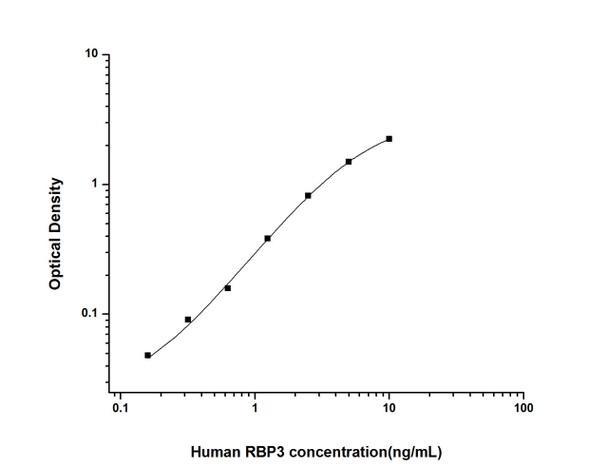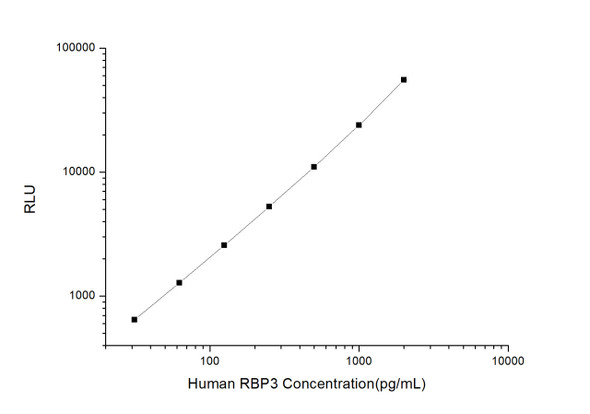Human Signal Transduction ELISA Kits
Human RBP3 (Retinol Binding Protein 3, Interstitial) ELISA Kit (HUES02595)
- SKU:
- HUES02595
- Product Type:
- ELISA Kit
- Size:
- 96 Assays
- Uniprot:
- P10745
- Sensitivity:
- 0.09ng/mL
- Range:
- 0.16-10ng/mL
- ELISA Type:
- Sandwich
- Synonyms:
- RBP-3, IRBP, RBPI, D10S64, D10S65, D10S66
- Reactivity:
- Human
- Sample Type:
- Serum, plasma and other biological fluids
- Research Area:
- Signal Transduction
Description
| Assay type: | Sandwich |
| Format: | 96T |
| Assay time: | 4.5h |
| Reactivity: | Human |
| Detection Method: | Colormetric |
| Detection Range: | 0.16-10 ng/mL |
| Sensitivity: | 0.10 ng/mL |
| Sample Volume Required Per Well: | 100µL |
| Sample Type: | Serum, plasma and other biological fluids |
| Specificity: | This kit recognizes Human RBP3 in samples. No significant cross-reactivity or interference between Human RBP3 and analogues was observed. |
This ELISA kit uses Sandwich-ELISA as the method. The micro ELISA plate provided in this kit has been pre-coated with an antibody specific to Human RBP3. Standards or samples are added to the appropriate micro ELISA plate wells and combined with the specific antibody. Then a biotinylated detection antibody specific for Human RBP3 and Avidin-Horseradish Peroxidase (HRP) conjugate are added to each micro plate well successively and incubated. Free components are washed away. The substrate solution is added to each well. Only those wells that contain Human RBP3, biotinylated detection antibody and Avidin-HRP conjugate will appear blue in color. The enzyme-substrate reaction is terminated by adding Stop Solution and the color turns yellow. The optical density (OD) is measured spectrophotometrically at a wavelength of 450 nm ± 2 nm. The OD value is proportional to the concentration of Human RBP3. The concentration of Human RBP3 in samples can be calculated by comparing the OD of the samples to the standard curve.
| UniProt Protein Function: | RBP3: IRBP shuttles 11-cis and all trans retinoids between the retinol isomerase in the pigment epithelium and the visual pigments in the photoreceptor cells of the retina. Belongs to the peptidase S41A family. |
| UniProt Protein Details: | Protein type:Secreted, signal peptide; Secreted Chromosomal Location of Human Ortholog: 10q11. 2 Cellular Component: extracellular space; extracellular region; vesicle Molecular Function:retinoid binding; serine-type peptidase activity; retinol binding; retinal binding Biological Process: phototransduction, visible light; visual perception; transport; lipid metabolic process; proteolysis; retinoid metabolic process Disease: Retinitis Pigmentosa 66; Retinitis Pigmentosa |
| NCBI Summary: | Interphotoreceptor retinol-binding protein is a large glycoprotein known to bind retinoids and found primarily in the interphotoreceptor matrix of the retina between the retinal pigment epithelium and the photoreceptor cells. It is thought to transport retinoids between the retinal pigment epithelium and the photoreceptors, a critical role in the visual process. The human IRBP gene is approximately 9. 5 kbp in length and consists of four exons separated by three introns. The introns are 1. 6-1. 9 kbp long. The gene is transcribed by photoreceptor and retinoblastoma cells into an approximately 4. 3-kilobase mRNA that is translated and processed into a glycosylated protein of 135,000 Da. The amino acid sequence of human IRBP can be divided into four contiguous homology domains with 33-38% identity, suggesting a series of gene duplication events. In the gene, the boundaries of these domains are not defined by exon-intron junctions, as might have been expected. The first three homology domains and part of the fourth are all encoded by the first large exon, which is 3,180 base pairs long. The remainder of the fourth domain is encoded in the last three exons, which are 191, 143, and approximately 740 base pairs long, respectively. [provided by RefSeq, Jul 2008] |
| UniProt Code: | P10745 |
| NCBI GenInfo Identifier: | 124894 |
| NCBI Gene ID: | 5949 |
| NCBI Accession: | P10745. 2 |
| UniProt Secondary Accession: | P10745,Q0QD34, Q5VSR0, Q8IXN0, |
| UniProt Related Accession: | P10745 |
| Molecular Weight: | 1247 |
| NCBI Full Name: | Retinol-binding protein 3 |
| NCBI Synonym Full Names: | retinol binding protein 3, interstitial |
| NCBI Official Symbol: | RBP3 |
| NCBI Official Synonym Symbols: | IRBP; RBPI; RP66; D10S64; D10S65; D10S66 |
| NCBI Protein Information: | retinol-binding protein 3; interphotoreceptor retinoid-binding protein |
| UniProt Protein Name: | Retinol-binding protein 3 |
| UniProt Synonym Protein Names: | Interphotoreceptor retinoid-binding protein; IRBP; Interstitial retinol-binding protein |
| Protein Family: | Retinol-binding protein |
| UniProt Gene Name: | RBP3 |
| UniProt Entry Name: | RET3_HUMAN |
As the OD values of the standard curve may vary according to the conditions of the actual assay performance (e. g. operator, pipetting technique, washing technique or temperature effects), the operator should establish a standard curve for each test. Typical standard curve and data is provided below for reference only.
| Concentration (ng/mL) | O.D | Average | Corrected |
| 10 | 2.291 2.301 | 2.296 | 2.236 |
| 5 | 1.544 1.552 | 1.548 | 1.488 |
| 2.5 | 0.887 0.873 | 0.88 | 0.82 |
| 1.25 | 0.425 0.459 | 0.442 | 0.382 |
| 0.63 | 0.23 0.206 | 0.218 | 0.158 |
| 0.32 | 0.156 0.146 | 0.151 | 0.091 |
| 0.16 | 0.104 0.112 | 0.108 | 0.048 |
| 0 | 0.055 0.065 | 0.06 | -- |
Precision
Intra-assay Precision (Precision within an assay): 3 samples with low, mid range and high level Human RBP3 were tested 20 times on one plate, respectively.
Inter-assay Precision (Precision between assays): 3 samples with low, mid range and high level Human RBP3 were tested on 3 different plates, 20 replicates in each plate.
| Intra-assay Precision | Inter-assay Precision | |||||
| Sample | 1 | 2 | 3 | 1 | 2 | 3 |
| n | 20 | 20 | 20 | 20 | 20 | 20 |
| Mean (ng/mL) | 0.53 | 1.38 | 3.71 | 0.48 | 1.42 | 3.76 |
| Standard deviation | 0.03 | 0.06 | 0.15 | 0.03 | 0.07 | 0.15 |
| C V (%) | 5.66 | 4.35 | 4.04 | 6.25 | 4.93 | 3.99 |
Recovery
The recovery of Human RBP3 spiked at three different levels in samples throughout the range of the assay was evaluated in various matrices.
| Sample Type | Range (%) | Average Recovery (%) |
| Serum (n=5) | 85-99 | 91 |
| EDTA plasma (n=5) | 94-107 | 101 |
| Cell culture media (n=5) | 86-99 | 93 |
Linearity
Samples were spiked with high concentrations of Human RBP3 and diluted with Reference Standard & Sample Diluent to produce samples with values within the range of the assay.
| Serum (n=5) | EDTA plasma (n=5) | Cell culture media (n=5) | ||
| 1:2 | Range (%) | 94-109 | 86-100 | 100-111 |
| Average (%) | 102 | 92 | 105 | |
| 1:4 | Range (%) | 88-102 | 84-95 | 84-97 |
| Average (%) | 95 | 89 | 90 | |
| 1:8 | Range (%) | 88-104 | 85-99 | 85-97 |
| Average (%) | 95 | 92 | 90 | |
| 1:16 | Range (%) | 86-101 | 85-99 | 82-96 |
| Average (%) | 93 | 90 | 89 |
An unopened kit can be stored at 4°C for 1 month. If the kit is not used within 1 month, store the items separately according to the following conditions once the kit is received.
| Item | Specifications | Storage |
| Micro ELISA Plate(Dismountable) | 8 wells ×12 strips | -20°C, 6 months |
| Reference Standard | 2 vials | |
| Concentrated Biotinylated Detection Ab (100×) | 1 vial, 120 µL | |
| Concentrated HRP Conjugate (100×) | 1 vial, 120 µL | -20°C(shading light), 6 months |
| Reference Standard & Sample Diluent | 1 vial, 20 mL | 4°C, 6 months |
| Biotinylated Detection Ab Diluent | 1 vial, 14 mL | |
| HRP Conjugate Diluent | 1 vial, 14 mL | |
| Concentrated Wash Buffer (25×) | 1 vial, 30 mL | |
| Substrate Reagent | 1 vial, 10 mL | 4°C(shading light) |
| Stop Solution | 1 vial, 10 mL | 4°C |
| Plate Sealer | 5 pieces | |
| Product Description | 1 copy | |
| Certificate of Analysis | 1 copy |
- Set standard, test sample and control (zero) wells on the pre-coated plate and record theirpositions. It is recommended to measure each standard and sample in duplicate. Note: addall solutions to the bottom of the plate wells while avoiding contact with the well walls. Ensuresolutions do not foam when adding to the wells.
- Aliquot 100µl of standard solutions into the standard wells.
- Add 100µl of Sample / Standard dilution buffer into the control (zero) well.
- Add 100µl of properly diluted sample (serum, plasma, tissue homogenates and otherbiological fluids) into test sample wells.
- Cover the plate with the sealer provided in the kit and incubate for 90 min at 37°C.
- Aspirate the liquid from each well, do not wash. Immediately add 100µL of BiotinylatedDetection Ab working solution to each well. Cover the plate with a plate seal and gently mix. Incubate for 1 hour at 37°C.
- Aspirate or decant the solution from the plate and add 350µL of wash buffer to each welland incubate for 1-2 minutes at room temperature. Aspirate the solution from each well andclap the plate on absorbent filter paper to dry. Repeat this process 3 times. Note: a microplatewasher can be used in this step and other wash steps.
- Add 100µL of HRP Conjugate working solution to each well. Cover with a plate seal andincubate for 30 min at 37°C.
- Aspirate or decant the solution from each well. Repeat the wash process for five times asconducted in step 7.
- Add 90µL of Substrate Reagent to each well. Cover with a new plate seal and incubate forapproximately 15 min at 37°C. Protect the plate from light. Note: the reaction time can beshortened or extended according to the actual color change, but not by more than 30min.
- Add 50 µL of Stop Solution to each well. Note: Adding the stop solution should be done inthe same order as the substrate solution.
- Determine the optical density (OD value) of each well immediately with a microplate readerset at 450 nm.






